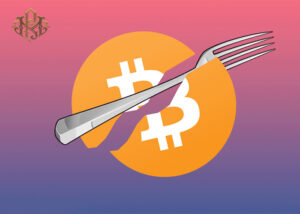Fork or branching in the language of blockchain technology refers to fundamental changes in the structure of a network. If you are familiar with blockchain technology, you will know that it is not possible to change the information recorded in the blockchain. Blockchain follows protocols that are implemented by programmers and are immutable. For example, in the Bitcoin blockchain, the block size is always 1 MB and the mining time of each block is 10 minutes.
What is a fork? Difference between hard fork and soft fork

Types of forks
- Soft Fork: A soft fork is a type of partial update that is compatible with the previous version. If network participants do not perform this update, they can still participate in validating and confirming network transactions. But for block registration by a miner who has not done this update, problems arise and the network rejects his block. A soft fork is a temporary fork, and the new fork is still compatible with the previous version.
Types of soft forks
Miner Activated Soft Fork (MASF): In this type, miners and users have the option to not accept the new update and continue on the previous path.
User Activated Soft Fork (UASF): In this type, changes are implemented at a specific time and date, and users are required to disapprove blocks and transactions that are not compatible with the new rules.
- Hard Fork (Hard Fork): Hard fork can be done in case of severe differences in the network. These differences may arise due to security issues, currency distribution, transfer speed, and similar issues. In a hard fork, fundamental changes are made to the software in such a way that it is not compatible with previous versions. A participant who fails to make this update will be permanently disconnected from the network. A hard fork actually creates a permanent fork in the blockchain.
Types of hard forks
- Planned Hard Fork: In this type of hard fork, if the community members agree to the changes and the fork is met with little resistance, it is done in a planned manner. This hard fork has two main purposes: to update the network and to make new updates and improvements. As a result, the old chain is removed and a new chain is developed. An example of this type of fork is the Byzantium hard fork for Ethereum, which happened with the aim of enabling faster transactions and greater security in the blockchain.
- Contentious Hard Fork: If there is a lot of opposition between members of a community, a planned hard fork is proposed as a solution. In this type of fork, the old chain is not deleted and two separate blockchains are created, both of which continue to operate as long as they are supported. An example of this type of fork is Ethereum Classic, which occurred after the Dao hack and created two new chains called Ethereum and Ethereum Classic.
The effects of creating a fork

Forks can have various effects on the movement of digital currencies or even change them altogether. These effects include the following:
Return of trust and lost capital: Some cryptocurrencies may be targeted by cyber attacks and lose traders’ capital. This experience occurred in situations such as the attack on the Ethereum cryptocurrency in 2016. The hard fork created on the Ethereum network restored the lost trust of users by creating a new currency called Ethereum Classic.
Bug Fixes and Network Improvements: Fork updates can help stabilize the cryptocurrency network and fix previous bugs. These updates also help strengthen network security.
Security discussion: Hard fork can lead to increased security in the blockchain network. This issue is very important for investors.





